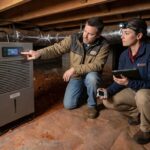Essential Guide to Choosing the Right Structural Repair Solutions for Your Home
Your home is your sanctuary, a space where you can unwind, host gatherings, and perhaps even hide from that one neighbor who just won’t stop talking about their cat’s latest antics. But what happens when the very structure of this beloved space starts to show signs of wear? Cracks on the walls, uneven floors, and doors that no longer close properly are not just aesthetic concerns; they could indicate underlying structural issues. When faced with such dilemmas, it’s crucial to choose the right structural repair solutions. This guide walks you through the essentials of selecting the best options for your home while keeping things light and engaging.
Understanding the Basics of Structural Damage
Before diving headfirst into repair solutions, it’s important to understand what constitutes structural damage. Structural issues can arise from various factors, including:
1. **Foundation Problems**: The foundation is the bedrock of your home (quite literally). Issues such as settling, shifting soils, or water damage can compromise its integrity.
2. **Moisture Issues**: Water is the enemy of a solid structure. Leaks, flooding, and high humidity can lead to rotting wood and mold.
3. **Pests**: Termites, rodents, and other pesky invaders can wreak havoc on your home’s structure, causing extensive damage before you even notice.
4. **Age**: Like fine wine, homes can improve with age—until they don’t. Older homes may develop structural issues simply due to the wear and tear of time.
Identifying Signs of Structural Damage
Spotting structural damage early can save you time, money, and a whole lot of stress. Here are some red flags you should be on the lookout for:
– Cracks in the walls (especially if they’re wider than a quarter inch)
– Uneven or sloping floors (your living room shouldn’t feel like a ski slope)
– Doors and windows that stick or don’t close properly
– Gaps between walls and ceilings
– Sagging roofs or roof leaks
If you notice any of these signs, it’s time to take action. Ignoring them is like leaving the last piece of cake unattended at a party—someone will eventually regret it!
Choosing the Right Structural Repair Solutions
Now that you know what to look for, how do you decide on the right repair solutions? Here are some essential considerations to guide you through the process:
1. **Assess the Severity of the Damage**
Before you call in the cavalry (i.e., contractors), you need to determine how serious the issue is. Is it a cosmetic fix like patching drywall, or is it more severe, requiring foundation repair? If you’re unsure, consider enlisting the help of a structural engineer or a qualified home inspector. They can provide a comprehensive assessment and recommend the appropriate course of action. Think of them as your home’s personal trainer—helping you identify the problem areas and suggesting ways to get everything back in shape!
2. **Decide Between DIY and Professional Help**
If you’re the kind of person who feels more at home with a hammer than a remote control, you might be tempted to tackle the repairs yourself. There are certainly some minor repairs that a handy homeowner can manage, like sealing small cracks or applying waterproof coatings. However, for major structural issues, leave it to the professionals. It’s like trying to bake a soufflé without a recipe—possible, but the results might not be pretty.
3. **Research Repair Methods**
There are various methods to address structural damage, each tailored to different types of issues. Here’s a brief overview:
– **Foundation Stabilization**: This might involve underpinning (adding concrete to support the foundation) or installing piers to support settling foundations.
– **Waterproofing Solutions**: To combat moisture, you might need to install drainage systems, sump pumps, or exterior waterproof coatings.
– **Pest Control Measures**: If pests are the culprits, you’ll need to implement pest control solutions, possibly including tenting for termites or sealing entry points.
– **Structural Reinforcement**: This could entail adding beams, re-framing walls, or reinforcing joists to enhance the overall stability of your home.
4. **Get Multiple Quotes**
Once you have a grasp of the potential solutions, it’s wise to obtain multiple quotes from contractors. This isn’t just about finding the cheapest option; it’s about ensuring you’re getting a fair price for quality work. Think of it as shopping for a new car—would you buy the first one you see without checking out the competition? We didn’t think so!
5. **Check Credentials and Reviews**
Before hiring a contractor, investigate their credentials. Ensure they are licensed, insured, and have good reviews. Websites like Yelp and Angie’s List can provide insights into customer satisfaction. Just remember, every contractor has had their fair share of disgruntled customers—so look for patterns rather than individual complaints.
6. **Understand the Warranty and Follow-Up Services**
A good contractor should offer warranties on their work. This is like a safety net for your investment—if something goes awry, you want to know there’s help available. Additionally, inquire about follow-up services to ensure the repairs remain effective over time. After all, you wouldn’t want to invest in a new furnace only to find out it’s underperforming six months later!
7. **Consider Long-Term Solutions**
When choosing structural repair solutions, think long-term. It might be tempting to opt for a quick fix, but addressing the root cause of the problem is critical to preventing future issues. For example, if the damage is caused by poor drainage, investing in a proper drainage system will save you headaches down the line.
8. **Plan for Disruption**
Some structural repairs can disrupt your daily life. Be prepared for the possibility of noise, dust, and limited access to certain areas of your home. If you’ve ever tried to bake cookies in a kitchen undergoing renovations, you know how challenging it can be! Plan accordingly—perhaps stock up on takeout menus and keep your favorite snacks handy.
9. **Maintain Communication with Contractors**
As your structural repairs progress, maintain open communication with your contractors. Ask questions and express any concerns as they arise. After all, if you’ve entrusted them with your home’s structure, you deserve to be in the loop. It’s your house; you should have a say!
10. **Regular Home Inspections and Maintenance**
Once the repairs are complete, commit to regular maintenance and inspections. Proactive monitoring can catch potential issues before they escalate, saving you time and money in the long run. Plus, you’ll feel like a responsible homeowner, which is a title worth flaunting.
Final Thoughts
Choosing the right structural repair solutions for your home can feel overwhelming, but with a little knowledge and preparation, you can navigate the process with confidence. Whether you’re dealing with a pesky crack, a leaky foundation, or an invasion of unwanted critters, understanding the severity of the damage and exploring your options will set you on the path to a safe and sturdy home.
Remember, your home is not just a property; it’s a place where memories are made (and, let’s face it, where you probably binge-watch your favorite shows). Protect that sacred space with the right structural repairs, and you’ll ensure that your home continues to be your cozy oasis for years to come. So roll up your sleeves and get ready to make those necessary fixes—after all, a solid foundation is the key to a happy home!


